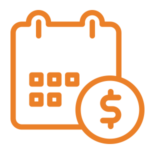Direct PLUS Loans
Direct PLUS loans are low-interest loans available to graduate and professional students to finance their own education, and to parents of dependent undergraduate students to help them finance their children’s education. A PLUS loan is intended to supplement any Direct Subsidized or Direct Unsubsidized loans for which a student is eligible.
Additional information about Direct PLUS loans is available online from the US Department of Education.
The US Department of Education (ED) makes Direct PLUS loans to eligible students and eligible parents borrowing on behalf of their eligible dependent students. ED and the students’ schools determine students’ eligibility (and for parent borrowers the parents’ eligibility) from data that the student provides on the Free Application for Federal Student Aid (FAFSA).
The school determines the amount of Direct PLUS loan funds the student or parent may borrow, considering the cost of attendance (COA) and other estimated financial assistance. Each school determines each student’s COA — an estimate of a student’s educational expenses for the period in which the student is enrolled. A student’s COA generally is the sum of:
- Tuition and fees, including costs of rental or purchase of equipment (including equipment for instruction by telecommunications), materials, or supplies required of all students in the same course of study
- Room and board, with adjustments for students who live at home with their parents, for students who live on campus, for students who live off campus but not with their parents, and for students who attend less than half time
- Books, supplies, transportation, and miscellaneous personal expenses, including a reasonable amount, as determined by the school, for the documented rental or purchase of a personal computer that the student will use for study purposes
- The origination fee for a Direct loan. A school may also include the fees required for private student loans.
- For a student with dependents, dependent care costs incurred during the student’s class time, study time, field work, internships, and commuting time
- Allowance for the one-time direct costs of obtaining a first professional license or certificate for students who are enrolled in a program that requires professional licensure or certification, if the cost is to be incurred during a period of enrollment, even if the exam is after the end of the period
- Reasonable costs of study-abroad programs approved for credit by the student’s home school
- For a disabled student, an allowance for reasonable expenses related to the student’s disability, including special services, personal assistance, transportation, equipment, and supplies
- Reasonable costs for students engaged in a work experience through a cooperative education program
A borrower may not qualify if he or she has adverse credit, has defaulted on a federal education loan, owes an overpayment on other federal student aid, has been convicted of a drug-related offense while receiving federal student aid, or is incarcerated. A borrower also may be ineligible if, while receiving federal student aid, he or she has been convicted of or has pled no contest or guilty to a crime involving fraud in obtaining federal student aid funds and has not completed the repayment of those funds.
Full details on eligibility criteria are provided on the Federal Student Aid website.
Federal law requires ED to perform a credit check before approving a Direct PLUS loan. Having no credit history is not considered adverse credit. However, an individual will generally be unable to obtain a Direct PLUS loan if he or she has:
- One or more debts with a total combined outstanding balance greater than $2,085 that are 90 days or more delinquent on repayment, or
- Federal student aid debt that has been subject to bankruptcy discharge, foreclosure, repossession, tax lien, or wage garnishment, or has been placed in collection or charged off during the two years preceding the date of the credit report.
Credit checks are generally handled through ED’s application system.
If a borrower has an adverse credit history, he or she may partner with a creditworthy endorser in order to obtain a Direct PLUS loan. An applicant for a PLUS loan who has an adverse credit history, but who obtains an endorser, or who documents to ED’s satisfaction that extenuating circumstances exist, must also complete ED’s PLUS loan counseling before receiving a PLUS loan. Contact the school or a federal loan servicer for more information.
After ED approves a Direct PLUS loan, it will send the borrower a disclosure statement providing details and terms of the loan. This disclosure becomes part of the MPN, so the borrower should keep this document until the loan is paid in full.
There are two exceptions to the interest rate charged on Direct PLUS loans.
- For Direct PLUS loans first disbursed on or after October 1, 2008, to active duty service members, no interest is charged during periods of qualifying active duty military service (for up to 60 months).
- If the student qualifies under the Servicemembers Civil Relief Act, an interest rate that exceeds 6 percent on a loan obtained prior to his or her active duty military service may be limited to 6 percent during his or her active duty military service.
Contact a federal loan servicer for more information on these exceptions.
In addition to interest, borrowers pay a loan origination fee for each Direct PLUS loan. Federal law specifies the maximum amount of the fee and authorizes ED to deduct the fee from the loan principal when the money is sent to the student’s school. The origination fee for a Direct PLUS loan is at least 4 percent of the loan principal.
A graduate or professional student must complete the FAFSA, and the student’s school must determine his or her eligibility for a Direct Unsubsidized loan before the student may apply for a Direct PLUS loan. After a student submits the FAFSA, ED determines his or her expected family contribution (EFC), calculated according to federal law, and the student’s school determines the financial aid award package, considering the student’s cost of attendance, EFC, and other estimated financial assistance. This package generally includes federal, state, or institutional grants or scholarships, the maximum amount of Direct Unsubsidized loan funds that the student may borrow, and the amount of Direct Student PLUS loan funds that the student may borrow.
A student may accept the maximum loan amount offered or a lesser amount when he or she completes a Master Promissory Note (MPN). Students can complete an MPN online or request a paper MPN from ED’s system or their school. Generally, one MPN covers all of the Direct PLUS loans someone borrows, but there may be circumstances under which a borrower is required to complete more than one MPN. For instance, if a parent borrower has more than one dependent in school at the same time, he or she must complete a separate MPN for each student. The school will inform a borrower in these cases. Borrowers may also request a new MPN any time they borrow. If a borrower doesn’t want to receive more than one loan under an MPN, he or she must notify the school or a federal loan servicer in writing.
The school may deliver some or all of a student’s loan money by crediting it to the student’s account at the school, or it may give it to the borrower directly by check or other means. The loan’s federal loan servicer will notify the borrower in writing each time the school delivers part of the loan money.
A graduate or professional student who hasn’t previously received a Direct PLUS or a FFELP PLUS loan must receive entrance counseling before the school can deliver the first disbursement of his or her loan. The entrance counseling provides information about the loan to make sure the borrower understands his or her options and responsibilities.
The maximum Direct PLUS loan amount is equal to a student’s cost of attendance minus other estimated financial assistance (including other Direct loans) that the student has been or will be awarded for the period of enrollment. The student’s school determines the amount a borrower is eligible to borrow and informs borrowers of the Direct PLUS loan amount for which they are eligible through an award letter. A borrower may accept a loan amount equal to or less than this eligible amount. The school must certify the student’s or borrower’s eligibility before ED approves a Direct PLUS loan.
A school may adjust the loan amount if a student’s or borrower’s financial circumstances or the student’s enrollment status changes. For example, if a student receives additional financial aid funds, the school may be required to adjust the amount of a Direct PLUS loan.
Before loan funds are delivered to the borrower, he or she may cancel all or part of the loan at any time by notifying the school.
After a borrower receives Direct PLUS loan funds, he or she may cancel all or part of the loan by informing the school within 120 days of the date the school delivered the loan money (by crediting the student’s account at the school, by paying it directly to the borrower, or both). If the borrower informs the school within the specified timeframe that he or she wishes to cancel all or part of the loan, the school will notify ED of the cancellation or the reduced loan amount. If the borrower asks the school to cancel all or part of a loan outside the specified timeframe, the school may choose to process the borrower’s cancellation request, but it isn’t required to do so.
Borrowers can choose from several repayment plans, and can switch repayment plans at least annually, or more frequently if ED agrees.
For a graduate or professional student, repayment plans are explained in more detail during the student’s exit counseling session.
Generally:
- ED requires a $50-per-month minimum payment unless the borrower makes other arrangements with ED.
- The payment amount must be equal to at least the monthly interest due on the loan.
- The standard repayment term is generally 10 years.
For a parent borrower, payments on a Federal Direct PLUS loan can be deferred while the parent is enrolled in school on at least a half-time basis. In addition, for a Direct Parent PLUS loan that is first disbursed on or after July 1, 2008, the parent borrower can request to defer payments:
- For the six-month period after he or she drops below half-time enrollment.
- While the student for whom the parent borrowed is enrolled at least half time and for the six-month period after the student drops below half time enrollment.
For a graduate or professional student borrower, payments on a Direct Student PLUS loan can be deferred while the student is enrolled in school on at least a half-time basis. In addition, a student can defer payments on a Direct Student PLUS loan for the first six months after he or she drops below half-time enrollment.
A deferment is a temporary postponement of a borrower’s monthly loan payment. During deferment of an unsubsidized loan, such as the Direct PLUS loan, principal payments are postponed but interest continues to accrue, and this accrued interest is added to the principal balance, or capitalized, at the end of the deferment period, increasing the total amount the borrower owes.





